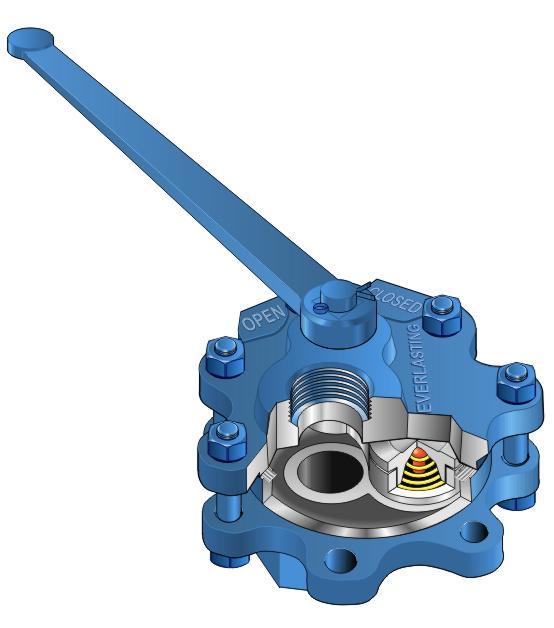Why Metal To Metal Seated Valves Are The Most Reliable Choice
05-20-21

Every year, a typical refinery or chemical plant emits as much as 700 tons of VOCs from leaks in valves, connectors, and pressure-relief devices. A major reason for those leaks is seal or gasket failure due to simple wear and tear or poor maintenance.
Choosing the best valves can help you combat fugitive emissions and reduce the risk of failures and downtime. Metal-to-metal seated valves can give you the best seal for your connections, especially when dealing with extreme environments like high temperatures, pressures, and chemicals.
What makes them one of the most effective types of valves out there? Let’s look at how these valves work and the uses for metal-to-metal seated valves in your plant.
Metal-Seated Valves
A soft-seated ball valve served to seal joints and connectors for many years. But they have many drawbacks if you work in more severe and extreme service conditions. They simply don’t handle high temperatures, slurries, and high pressure very well.
Operating conditions continue to subject valves to those kinds of tough conditions. Metal-seated ball valves have the design flexibility to deal with critical issues around fire safety and leak rate.
They came about as an answer for the shortcomings of the soft-seated valves. Their ability to handle extreme conditions makes them ideal for use in industries and locations like the following:
- Oil refineries
- Mining
- Electric power generation
- Petrochemical
- Pulp and paper mills
The metal used in these valves differs depending on the setting in which they’ll be used. Copper alloys work fine in low-pressure valves, while nickel-based alloys are the choice for corrosive media.
Metal-to-Metal
With traditional gaskets, the seal takes the total load and limits how much load can be applied. The use of metal seals with an optimized interface is recommended for best performance under loads. This metal-to-metal seal controls compression by placing the seal in a groove or using a spacer. It provides a barrier to prevent a blowout in high-pressure situations.
Another key aspect of these metal to metal seals is the surface finish of the touching surfaces, which must be carefully tied to the seal material. Even with proper finishes, the circle of the seals deforms a bit each time it creates a sealing barrier. Radial machining marks and scratches can become potential leak paths over time.
Designing for Durability
While metal seated ball valves can provide the strongest seal in harsh conditions, wearing marks and scratches are examples of the biggest challenge they have. Figuring out how to overcome that to improve durability over time. After all, you want to avoid installing seal valves repeatedly because they begin to leak.
The most standard way of trying to deal with the wear and tear on metal valves is with specialized coatings that can handle severe service applications like high temps, hydraulic shock, or corrosion resistance. Hard coatings are required, so tungsten carbide is a popular choice. Other carbides might be used in higher temp situations or when greater hardness matters.
With metal-to-metal seal contact, coatings make for a smoother sliding operation and reduce friction. It’s a key part of how a seal is achieved by a metal-seated ball valve.
Everlasting goes a step beyond with our metal seals, using a self-lapping, rotating disc technology. Each time the valve opens and closes, the surface rotates a bit. The process renews and polishes the metal seat and clears process material away. The unique design allows for more symmetrical wear. Keeping the wear evenly spread out avoids creating weak points that eventually become leaks. It allows Everlasting valves to perform longer before they need replacing.
You get the hard-wearing benefits of metal with the same tight sealing action of a soft-seated valve. This makes them proven tech for harsh environs like cement production, power generation, and petroleum production and refining.
Choosing one of these options for valves means you experience less downtime and fewer repair issues. So while metal-seated valves can cost more upfront, you should consider the total cost of ownership and your specific environment requirements in picking a valve.
Uses and Applications
Metal seated ball valves are made to handle abrasive mediums, corrosives, and high temperature or pressure. Most of the time, they are used in isolation, but they can also be used for uni and bi-directional control because of the tight seal they provide.
You can choose from different valve sizes based on the application as long as your valve meets ANSI class IV leakage standards. You’ll find many different valve applications that make use of metal-to-metal seats, including:
- Body-bonnet connections
- Pressure-balanced plugs
- Stem sealing
- Back-seat sealing
With soft elements, the seal might degrade and cause leakage under high temperatures. The addition of Teflon seats allows you to go up to 600 degrees F. But full metal valves allow for temperature resistance up to 1,500 degrees.
Metal seals can come in butterfly form as well, which allows for bi-directional flow and are effective for high-pressure applications. They offer a thinner profile, lighter weight, tighter seals, and reduced wear.
Looking for Metal-to-Metal Seated Valves?
For the tightest seal under extreme conditions, metal-to-metal seated valves provide you with the most secure option to keep chemicals and fumes from escaping. The design of the valve can improve the seat over time and reduce your downtime and repair budget.
Our customers have valves still in operation more than 50 years after they were installed. Contact us to get a quote on installing seal valves in your plant and whether metal to metal is the right choice for you.